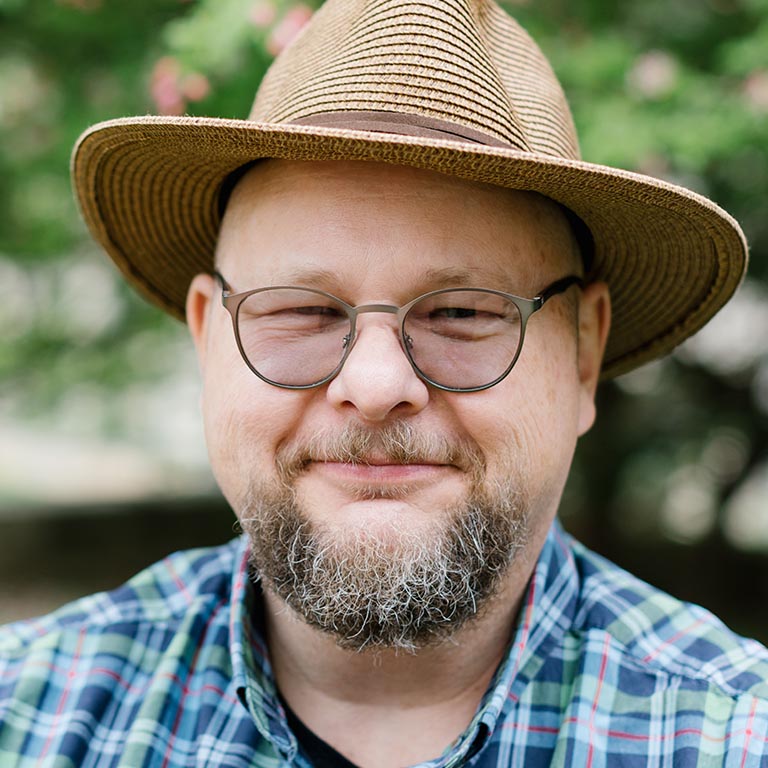- Ph.D., Emory University, 2001
- M.A., Arizona State University, 1997
- B.A., Arizona State University, 1992

Kevin Jaques
Associate Professor, Religious Studies
Adjunct Professor, Near Eastern Languages and Cultures

Associate Professor, Religious Studies
Adjunct Professor, Near Eastern Languages and Cultures
I am interested in the study of medieval Islamic theology and law, especially in how medieval Muslim historians understood and depicted the development of theological and legal institutions between the death of Muḥammad in 632 CE and the late sixteenth century. I primarily focus on various forms of biography (tarjamah), which was one of the most important genres of medieval Muslim historiography. I also have a secondary interest in Islam in Indonesia, especially the stories of the Wali Songo, the nine saints of Javanese Islam that are popularly thought to be responsible for the Islamization of Java in the fifteenth and sixteenth centuries.
I have written two books, Authority, Conflict, and the Transmission of Diversity in Medieval Islamic Law (Brill, 2006) and Ibn Ḥajar al-ʿAsqalānī (773-852/1372-1449) (Oxford, 2009). Both texts focus on late medieval Muslim scholars of the Shāfiʿī school of law. The first examines the historical views of Abū Bakr Ibn Qāḍī Shuhbah (d. 1448) as they are depicted in his biographical collection Ṭabaqāt al-fuqahāʾ al-Shāfiʿī (The Generations of the Shāfiʿī Jurists). The second is a biography of one of the most prominent religious scholars of the fifteenth century, Ibn Ḥajar al-ʿAsqalānī (d. 1449). In both I argue that the context of their lives and careers: persistent outbreaks of the plague, famine, economic and political instability, constant civil war, and the religious upheavals that resulted from them all shaped their understandings of Islamic history, especially the development of religio-legal authority as a means of meeting the challenges posed by the apocalyptic events of their era. Where Ibn Qāḍī Shuhbah sought to explain the events of his period in the context of legal history and the rise of new models of religious authority, Ibn Ḥajar attempted to be a model of authority through his own charismatic leadership as a judge and religious scholar.
For the past year I have worked with the “Knowledge, Information Technology, and the Arabic Book" (KITAB) project funded by ongoing grants from the European Research Council (ERC), the Qatar National Library (QNL), and Aga Khan University-Institute for the Study of Muslim Cultures (AKU-ISMC). On the KITAB project I serve as the principle Sirah expert on the QNL-funded “Digital Sirah Project” (DSP), an initiative that combines traditional methods of textual discovery and machine learning technologies with the goal of developing algorithms that are capable of locating textual reuse in a ~1.5 billion word corpus of classical Arabic texts. Over the past twelve years I have reconstructed a massive collection of previously "lost" witnesses to the Sirah (Biography) of the Prophet Muhammad, written by Muhammad b. Ishaq (d. 150/767). These lost witnesses were recovered from quotations (most nothing more than small fragments) found in over 300 texts from a corpus of over 5,000 modern editions of classical Arabic works by using simple search threads and by more "traditional" methods of close reading. The DSP seeks to develop machine-learning algorithms that would do in days what I spent over a decade doing and uses my research as "ground truth data," checking its results against my established collection and attempting to locate passages that my traditional methods missed. Each test involves checking outputs against my collection, fine tuning the algorithm in order to "train" it to discover the fragments of Ibn Ishaq that lie buried in the classical Arabic corpus.
Over the next four years (2019-2023), I will apply the digital methods we are developing to the creation of an open-access digital edition of the entire Ibn Ishaq collection. My edition will bring the study of the Sirah into the digital age and will initiate a new way of understanding early Muslim texts and history. The goal is to allow readers to interact with the Sirah in a way not possible with traditional “critical” editions that harmonize differences and erase traces of the distinct socio-cultural situations in which works were produced (indeed, the Sirah belongs not to one situation but to many). The digital edition will allow users to:
The digital tools we are developing for DSP, which will be repurposed for my edition, will provide a previously impossible opportunity to map how socio-cultural, regional, tribal, and political differences shaped Muslim presentations of central historical events, people, and ideas. Besides the DSP, my own project leverages other work undertaken by team members and institutional partners. This includes, especially, OpenITI, a multi-institutional corpus building project to which the AKU and KITAB contribute. OpenITI maintains an open-access collection of over 5,000 classical Arabic texts. I also leverage the work of al-Thurayya (https://althurayya.github.io/), a geospatial model of the early Islamic world, developed by KITAB members, that will link to visualizations to show the places Ibn Ishaq performed the text and how location and local population might have influenced his performances.
“Murder in Damascus: The Consequences of Competition among Medieval Muslim Religious Elites,” Mamluk Studies Review, 2016.
“Muḥammad’s Mission and the Dīn of Ibrāhīn according to Ibn Isḥāq.” In Varieties of Religious Invention. Edited by Patrick Gray. Oxford University Press, 2015.
"The Gestation of Arabic Biography," in The Oxford Handbook of Hadith Studies, Mustafa Shah ed. (Oxford: the University Press) (under contract).